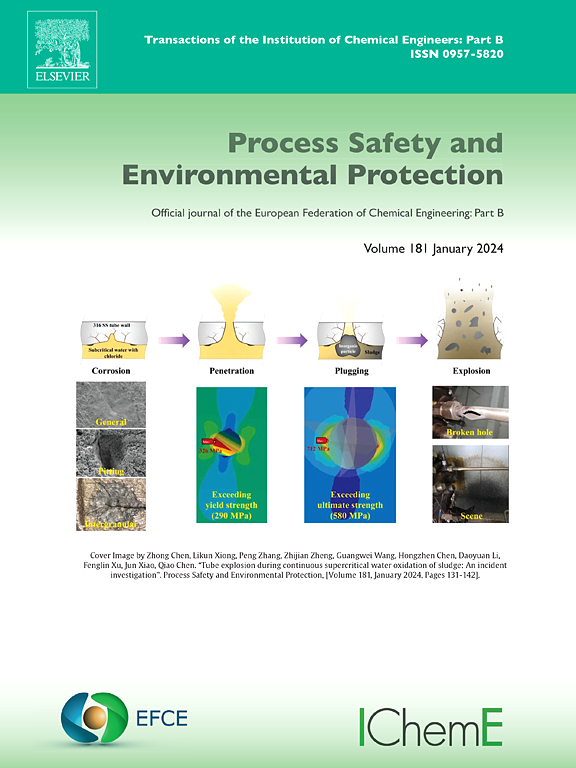Environmental hazards of coal fires: Fracture-driven radon anomalies and migration
IF 7.8
2区 环境科学与生态学
Q1 ENGINEERING, CHEMICAL
引用次数: 0
Abstract
Underground coal fires pose critical threats to mining safety, energy security, and environmental sustainability. This study investigates the Haizhou Open-pit Mine, where field measurements detected elevated radon concentrations along surface fractures, with peak value exceeded 10,000 Bq/m³ . It demonstrates the fracture’ pivotal role in gas migration. A 1-D steady-state migration model was established to evaluate the competing effects of diffusion, convection, and radioactive decay. The model demonstrates that radon can reach the surface from depths over 1000 m at high seepage rates (v>10⁻³ m/s). Furthermore, a 3-D multiphysics model was constructed, incorporating derived relationships between temperature and radon generation from the closed radon accumulation system. Results show that elevated coal temperatures and fracture-related parameters significantly enhance surface radon response. Convective transport within fractures dominates radon migration, amplifying surface concentrations by over 60-fold when fracture widths expand from 0.7 mm to 1.5 mm. Fracture density and fire zone area expansion demonstrate positive correlations with radon anomaly, while increased burial depth leads to substantial attenuation due to radioactive decay. These findings contribute valuable insights for precise coal fire inversion and geological hazard assessment.
煤火的环境危害:裂缝驱动的氡异常和迁移
地下煤火对采矿安全、能源安全和环境可持续性构成严重威胁。本研究以海州露天矿为研究对象,现场测量发现沿地表裂缝方向氡浓度升高,峰值超过10000 Bq/m³ 。说明了裂缝在天然气运移中的关键作用。建立了一维稳态迁移模型来评估扩散、对流和放射性衰变的竞争效应。该模型表明,氡可以从1000 m以上的深度以高渗透速率(v>10⁻³m/s)到达地表。在此基础上,建立了三维多物理场模型,推导了封闭氡积累系统中温度与氡生成的关系。结果表明,煤温和裂隙相关参数的升高显著增强了地表氡响应。当裂缝宽度从0.7 mm扩大到1.5 mm时,裂缝内的对流输送主导了氡的迁移,使表面浓度增加了60倍以上。裂缝密度和火区面积的扩大与氡异常呈正相关,而埋深的增加导致放射性衰减。这些发现为精确反演和地质灾害评价提供了有价值的见解。
本文章由计算机程序翻译,如有差异,请以英文原文为准。
求助全文
约1分钟内获得全文
求助全文
来源期刊

Process Safety and Environmental Protection
环境科学-工程:化工
CiteScore
11.40
自引率
15.40%
发文量
929
审稿时长
8.0 months
期刊介绍:
The Process Safety and Environmental Protection (PSEP) journal is a leading international publication that focuses on the publication of high-quality, original research papers in the field of engineering, specifically those related to the safety of industrial processes and environmental protection. The journal encourages submissions that present new developments in safety and environmental aspects, particularly those that show how research findings can be applied in process engineering design and practice.
PSEP is particularly interested in research that brings fresh perspectives to established engineering principles, identifies unsolved problems, or suggests directions for future research. The journal also values contributions that push the boundaries of traditional engineering and welcomes multidisciplinary papers.
PSEP's articles are abstracted and indexed by a range of databases and services, which helps to ensure that the journal's research is accessible and recognized in the academic and professional communities. These databases include ANTE, Chemical Abstracts, Chemical Hazards in Industry, Current Contents, Elsevier Engineering Information database, Pascal Francis, Web of Science, Scopus, Engineering Information Database EnCompass LIT (Elsevier), and INSPEC. This wide coverage facilitates the dissemination of the journal's content to a global audience interested in process safety and environmental engineering.
 求助内容:
求助内容: 应助结果提醒方式:
应助结果提醒方式:


